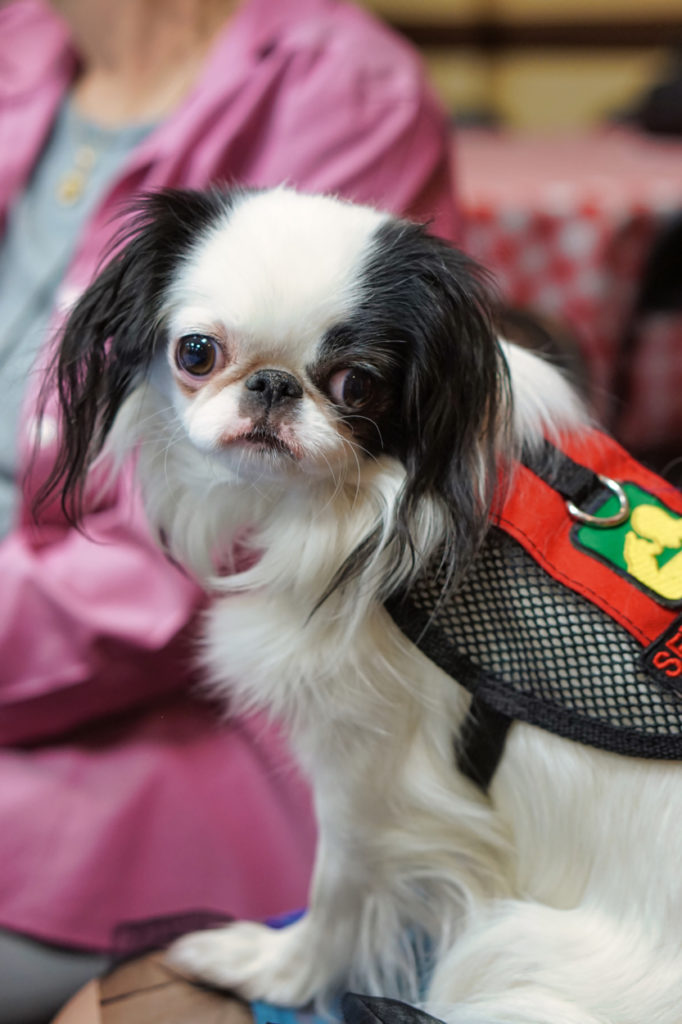Article by Dr. Veronica Morris, Ph.D. with Bradley W. Morris, M.A., C.Phil.
When people see me out and about with Hestia, my eight-pound Japanese Chin service dog, I often get questions about how such a small dog can be a service dog.
People ask me what on earth a dog that small could do for me — couldn’t a standard-sized Labrador or golden retriever have better suited my purposes? And shouldn’t my service dog be “four on the floor” all the time? Otherwise, we look like fakers, right?
I’m going to assume you’ve heard service dogs can be lifesavers for disabled people like me, and I’m not going to try to convince you that people with mental health disabilities can legitimately use service dogs. That’s just the law! Here we’re going to delve into small service dogs of unusual size, and why they might (or might not!) be appropriate for other folks with disabilities.
Let’s look at some quick reasons someone might favor a small service dog over a bigger one. With small service dogs:
1. They’re cheaper to feed.
2. Their gear costs less.
3. There’s less worry about the general public (and even the service dog user) being fearful of the dog due to its size.
4. They can generally learn and perform most medical alerts or responses as well as any larger dog.
I’ve worked with service dogs of quite different sizes. My first service dog was an 18-inch Weimaraner and pit bull mix named Sabrina. My second service dog was a huge 28-inch Standard Poodle named Ollivander (Ollie). So, I’ve had medium and large versions of a service dog, as well as now the small/toy version. All three have been psychiatric service dogs for my bipolar disorder, post-traumatic stress disorder (PTSD) and agoraphobia.
Sabrina was a middle-sized dog, and so in a lot of ways wasn’t ideal for me. She couldn’t provide pressure therapy unless she was sitting in my lap, and she was 45 pounds, which is a little big to sit on my lap at a restaurant or in class! Something I didn’t even notice at the time is that I couldn’t use her while walking about.
With Ollie, I had a dog as tall as a short Great Dane. I found that being able to pet his head while walking along was incredibly helpful to ground myself while on the go. Ollie loved standing — he could doze off while standing! So when he went underneath tables at restaurants or during class, he would stand and rest his head on my lap. I found this inconspicuous stance and pressure was enough to help me get out of episodes, calm down and stay calm.
This led me to realize I need three things out of my service dog:
1. I need a dog that can alert or respond to my panic attacks and mood swings.
2. I need to be able to touch my dog while walking so I can get that help on the go.
3. I also need a dog that provides pressure therapy.
This left me with a choice — I could either go with a small dog I could sometimes carry and could provide me with pressure therapy and grounding on the go. Or I could go with a large breed I could touch while walking, and would be able to occasionally give me inconspicuous pressure therapy with their head on my lap like Ollie did.
I chose small, and I have no intention of going back! Hestia is the perfect size for me in so many ways that I could not have anticipated.
Some people argue she is too small for pressure therapy, but what’s important is what works for the individual with the disability, not what others think. Personally, I just need a little bit of a certain kind of sensory stimulus to keep me grounded and engaged with the world, rather than dissociating or entering panic attack territory.

Hestia weighs the same as Ollie’s head, and that is how he provided most of the pressure therapy I got from him — by placing his head in my lap. She often provides the same amount of pressure as Ollie’s head did just by remaining on my lap in position (as I took pains to train). This is why I have her on my lap so often when I’m sitting down.
Through positive reinforcement, I’ve also taught Hestia to “lean.” When I’m having a hard time, I can carry her and she will lean all her body weight into my chest, pushing off from my arms. On my hard days, I often “pouch” her in a ring-sling designed for an infant. This way, my arms are free and she can push against the pouch to lean into my chest and provide pressure therapy on the go when unwanted episodes can strike out of nowhere.
Pressure on my chest actually works better in a crisis than lap pressure. This means that when I’m having an unusually rough time, I have a go-to way of surviving a pounding panic attack or stupefying anxiety. I can hold her in my arms, carry her hands-free on the front in a baby pouch, or have her lie on top of me when I’m practically horizontal.
This is why you might see me having my dog in a colorful pouch while trying to tick off the grocery list on a Wednesday night, rather than not seeing me in public at all. It’s not because I’m silly — it’s because I’m surviving.
That’s all about me, but what’s more, small dogs can give someone independence by doing things like:
1. Retrieving dropped items.
2. Leading you out of a store if you are having an episode and need to exit. (Yes, “guide work!”)
3. Alerting to sounds, blood sugar extremes, flashbacks, night terrors and many other medical issues.
This is not to say small dogs are perfect for everyone! There are some potential negatives to watch out for. A small dog:
1. Won’t be able to provide enough pressure for those who actually need more weight.
2. Cannot (should not!) do weight-bearing mobility work.
3. Is taken much less seriously than other service dogs, just because of their size.
4. Can be cute in a way that makes it hard to get errands done because everyone wants to pet them and marvel at their size.
So, I hope the next time you see a small-breed service dog, especially one being carried in arms or in a pouch, you’ll realize there can be a lot of benefits to these smaller guys. Since a small dog being carried is not necessarily a “fake” service dog, exercise your newfound knowledge and empathy and be careful when playing “service dog police.”
Small dogs rule! Big dogs drool! (Someone grab the slobber rag.)
Images via contributor.

